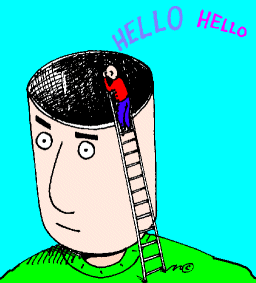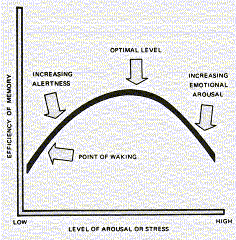What Can I Do To Increase the Effectiveness of the Learning Experience?
Outline
Page 1 Affective Behaviors
Page 2 Knowledge Sharing by
Claire Belilos
Page 3 The Mayor of Bogota
Page 4 Self Confidence
Page 5 Self
Page 6 Changing BehaviorsAffective Behaviors
Getting someone to change their affective behavior is one of the hardest tasks to accomplish. That is because the training often threatens the learners' self-image. So, it becomes important to affirm the learner's core values, such as moral, social, religious, family, political, etc. Learners who attend training in which their beliefs or values are supported are much more likely to "let down their guard" and accept the learning points.

If you confront the learners with learning points that suggests they may have acted in a foolish or in a dangerous manner, they become resistant to change. No one wants to be told that they did something stupid. Thus, it is important to remind them of their "goodness" in order to make the various learning points easier to digest. The learning will not be so threatening because thinking about an important value will have affirmed each learner’s image of himself or herself as a smart and capable person. This also points out the invalid concept of a learner as an empty vessel. You have to "draw" them into the learning, not simply "pour" the learning into them.
Why is safety so hard to train?
(NOTE: The following example uses safety, but this method works with a wide variety of affective behaviors.
Unlike a lot of other tasks, it is often easier to do something the unsafe way, rather than the safe way. For example, if I run out of charcoal lighter, it is much easier and quicker to use the can of gasoline in the garage than drive two miles to the nearest store; it is much quicker to cross in the middle of the street than walk to the corner-crosswalk; it is faster and easier to jump on a piece of equipment and start operating than to perform some checks beforehand.
Getting someone to act safely requires that they not only gain the required knowledge and skills, but that they also change their attitude (affective domain). Otherwise, they will know how to act, but will not do so as their self-systems kick in and convince them to do it the fast and easy way.
We all perform calculated risks (which in reality are unsafe acts to various degrees), e.g., I might never use gasoline to start a barbecue (unless I was starving and had no means to get fluid), but I might cross the street outside of the crosswalk if it was not busy.
This is why organizations have safety class after safety class - they never getting around to changing the attitudes of the learners. They hope that drilling the same old knowledge and skills into the learners with various methods will eventually pay off and produce safe learners. However safety requires that we know the rules (knowledge), know how to act (skills), and have a proper attitude for it (affective).
One Solution
A learning program might go something like this (I am keeping this simple so that you can add, remove, or adjust the steps for other behaviors):
| Have each learner explain three or four safety rules or principles that they value dearly and why. Also, have them record their selections on a flip chart. | |
| This helps to internalize the belief that they are "good" persons, which makes them more receptive to change. This is best done in small groups (mix the groups up throughout the various activities). |

Sort of like "cheerleading."
| Gather the groups back together and have them discuss their values or principles. Tape these values to the walls so that they may be used for further reminders. | |
| Discuss the concept of the difficulty of getting people to act safely (e.g. it is often quicker and easier not to act in a safe manner). | |
| Again, using small groups, have them discuss calculated risks (unsafe acts) that they have performed, e.g., not coming to a complete stop at a stop sign. Have them record the reasons on a flipchart. | |
| Next, have them confront the inappropriate behaviors by asking why we take these risks when they might clash with our core values and principles. (Note: You can have them discuss a number of other things depending on your desired outcome - e.g. discuss if the reasons they listed for taking the "risks" are the same reasons other employees might use. If not, what might some of their reasons be?) | |
| Gather them back together and using their input, extract the central themes of their discussions. | |
| Have them brainstorm some activities or solutions that they can use in their workplace to make it a safer place (this allows them to become part of the solution). For ideals on brainstorming activities, see Brainstorming |
Changing Affective Behaviors Is Not Easy
Note that changing affective behaviors is generally not a one shot activity. But, going to the core of the matter is better than repeating the same old skills and knowledge that they already understand. Building a wide variety of these "cheerleading" activities will give you the three required building blocks of learning difficult behaviors:
| Gaining new skills, | |
| learning new knowledge, | |
| and changing Affective behaviors. |
Page 2 - Knowledge Sharing
Page 3 - The Mayor of Bogota
Page 4 - Self Confidence
Page 5 - Self
Page 6 - Changing Behaviors
Yerkes-Dodson Law: Arousal and Learning
Introduction
Arousal is a major aspect of many learning theories and is closely related to other concepts such as anxiety, attention, agitation, stress, and motivation. The arousal level can be thought of as how much capacity you have available to work with. One finding with respect to arousal is the Yerkes-Dodson law (1908) which predicts an inverted U-shaped function between arousal and performance:
There has been quite a bit of research indicating the correlation suggested by Yerkes and Dodson exists (Broadhurst, 1957; Duffy, 1957; Anderson, 2000), but a cause of the correlation has not yet been fully established (Anderson, Revelle, & Lynch, 1989). Although the Yerkes-Dodson law is quite old, it has held up in time through numerous studies. Just because something is old, does not make it invalid. In fact, since it has held up for so long, is the reason it has gone from theory to law.
A certain amount of arousal can be a motivator toward change (with change in this discussion being learning). But too much or too little will certainly work against the learner. You want some mid-level of arousal to provide the motivation to change (learn). Too little arousal has an inert affect on the learner, while too much has a hyper affect. Also, there are optimal levels of arousal for each task to be learned. The optimal level of arousal is:
- lower for more difficult or intellectually (cognitive) tasks
- higher for tasks requiring endurance and persistence
You might think of arousal and cognitive levels as fluid in a glass. If you put too much of any ingredient in the glass, it overflows. On the other hand, if you put too little in, you are not using the glass to its fullest capabilities. And if you put the wrong ingredients in, but the glass is full, then it does not taste good.
Recent Research and Findings
A University of Chicago researcher reported performing tests on the influence that a stress-related hormone has on learning in ground squirrels and that it could have an impact on understanding how it influences human learning. Jill Mateo (2007), Assistant Professor in Comparative Human Development, said that modest levels of cortisol are apparently linked to their survival. The inverted U, similar to Yerkes-Dodson's law, is the shape data forms on a chart. Animals with low levels of cortisol are at the left of the inverted U, and those with high levels are at the right, while those with modest levels and higher learning are in the middle. You can find more information on this story at Science Daily.What does this mean for the Learning Environment?
Environmental arousal factors such as the noise level, temperature, comfort, must be controlled. This allows you to put more arousal factors that are beneficial to learning without going into arousal overload. A colleague of mine once had to give some training at a meat packing company. The only place they had for him to train was in a cold storage room. He managed to get through the training by leaving out most of the arousal factors that he normally uses. The cold room had already overloaded the learners' peak arousal level (stress) and he did not want to arouse them anymore.When training tasks that are high on the cognitive scale or are highly complex, use less motivators and keep the stress level low. The brain tends to shut certain aspects out when it has too many inputs coming in at once, and the one input that you do not want it to shut out is what your learners need to learn. Some trainers call this brain-overload, tunnel vision, or brain-cramps. This does not mean you cannot make the material interesting, just keep their arousal on an even keel. You want them to focus on the learning activities, not inputting more information into their brains with motivational speeches and stressors.
Outdoor or physical team training activities require more arousal techniques. This is where the trainer has to become more of a college football type coach and less of a trainer. The effort to reach the peak arousal point where the most change (learning) takes place is higher on this scale than cognitive learning. To reach that peak arousal point you need to provide more stress and motivation. This is why such team training programs as the U. S. Armed Forces Basic Training creates great teams -- they reach the arousal point that is on the high-end for this type of learning.
Tests can be great motivators for getting students to learn. . . it shows they mastered the task, they do not like to fail, they want that certificate, its a challenge, etc. But test taking anxiety can push some learners' arousal level over the peak arousal point. You can reduce stress levels by supplying non-graded quizzes and performance activities that provide reassurance and feedback to the learners.
When the optimum arousal point goes too low then use activities that get the learners interacting with each other or moving. Provide inspirational speeches, challenging games, and puzzles. Give a pop quiz.
When the optimum arousal point goes too high then take the cognitive focus off the goal (eliminate "what if" statements) and place it on the process. Take a break, watch a video, stretch. Play a fun, but interesting game.
Provide the who, what, when, where, why, and how questions about the learning to take place as it helps to eliminate fears. . . you and the learning environment need to control the stress factors, not the unknowns.
Anxiety and Arousal
Many trainers believe that all anxiety must be removed from the training environment. But, again, there is an optimal level. The Optimal Arousal Level can be thought of as the Optimal Motivational Level. And one of the things that motivate people is anxiety. But, many people seem to have a negative connotation to the word "anxiety" as they associate it with neurotic inferences. It might help to picture anxiety in three terms as Freud did:- Reality anxiety: the fear of a real danger in the external world that alerts the ego to danger. NOTE: This is the type of anxiety needed in some types of training, while the next two need to be eliminated.
- Neurotic anxiety: the fear that one's inner impulses cannot be controlled (id).
- Moral anxiety: the fear of the retributions of one's own conscience (superego).

When you take anxiety out of the training environment, you leave the learner without a major motivator. There is an old learning theory (now discredited) that states "the learner is an empty vessel in which the instructor pours knowledge." And unintentionally, this is how many training environments now operate. All the learners have to do is show up for the training session and they pass as the training environment has been completely sanitized of all emotions. The trainers believe that their entertaining and interesting instruction is going to be "poured" into the learners.
Excellent training places the responsibility of learning on both the trainer and the learner -- the trainer provides the learning tools, while the learners' responsibility is to use these tools. And by creating an anxious-free environment, you take away one of the major motivational tools of the learner.
Perhaps anxiety's most effective use in training would be in a safety class. Pilots go through simulators not only for the psychomotor practice and to increase their knowledge, but also because some of the simulations are so realistic that they get anxiety attacks that tell them "danger, do something now!" not "something is going wrong, lets wait and see what happens." These types of anxiety attacks are our friend, they tell us to take immediate action by releasing adrenaline into the bloodstream, stimulating the heart, raising the metabolic rate, and increasing the blood glucose concentration.
Safety is not only having the knowledge to do things the correct way, the skills to perform correctly, but also the ATTITUDE to REACT to unsafe conditions. I'm sure some are going to jump on the band-wagon and say its unethical for trainers to change attitudes, or you change behaviors not attitudes, but that is a training cop-out. I work in a plant with forklifts, conveyors, machinery, and many other potential hazards. When I leave work I want to do so via my car, not in a hearse on the way to the county morgue or in an ambulance with an amputated leg because the people who work with me "displayed safe behaviors" but did not have the attitude to react to something going wrong or sense (become anxious) when they were about to do something dangerous. Failing to incorporate affective (attitude) domain training into a safety classes means that you, the trainer, failed at your task.
The Learning Zone
How do you know when you have reached the optimum arousal point for your learners? In sports, a player who is playing great is at the optimum arousal point and is said to be "in the zone." Achieving the optimum arousal level in a training environment puts students in the Learning Zone:- They become totally involved in the learning process by centering in on the task to be learned as non-learning stressors have been eliminated.
- They loose self-consciousness of the fear they might fail and gain a desire to succeed as their emotions are now tied to the learning environment. Failing becomes challenges because they become more adaptive to the learning environment and they believe the learning environment will "fine tune" itself to meet their needs.
- They have clear visions of what the task to be learned can provide as they know how it will help them in their future endeavors.
- They have a sense of being in control of their learning environment as they are ripe for learning (they are NOT just going through the motions).
- They become more intrinsically motivated (self-directed) because they want to learn the task (their focus is on the task rather than reward and punishment).
References
Anderson, J.R. (2000). Cognitive psychology and its implications. 5th Ed. New York: Worth.Anderson, K. J., Revelle, W., & Lynch, M. J. (1989). Caffeine, impulsivity, and memory scanning: A comparison of two explanations for the Yerkes-Dodson Effect. Motivation and Emotion, 13, 1-20.
Broadhurst, P. L. (1957). Emotional Psychology, 54, 345352.
Duffy, E. (1957). The psychological significance of the concept of "arousal" or "activation." Psychological Review, 64, 265275.
Mateo, J. M. (2007). Inverted-U shape relationship between cortisol and learning in ground squirrels. Journal Neurobiology of Learning and Memory (online). Neurobiol Learn Mem. Dec 27.
Yerkes, R.M. & Dodson, J.D. (1908). The Relationship of Strength of Stimulus to Rapidity of Habit Formation. Journal of Comparative Neurology and Psychology., 18, 459-482.


Tidak ada komentar:
Posting Komentar